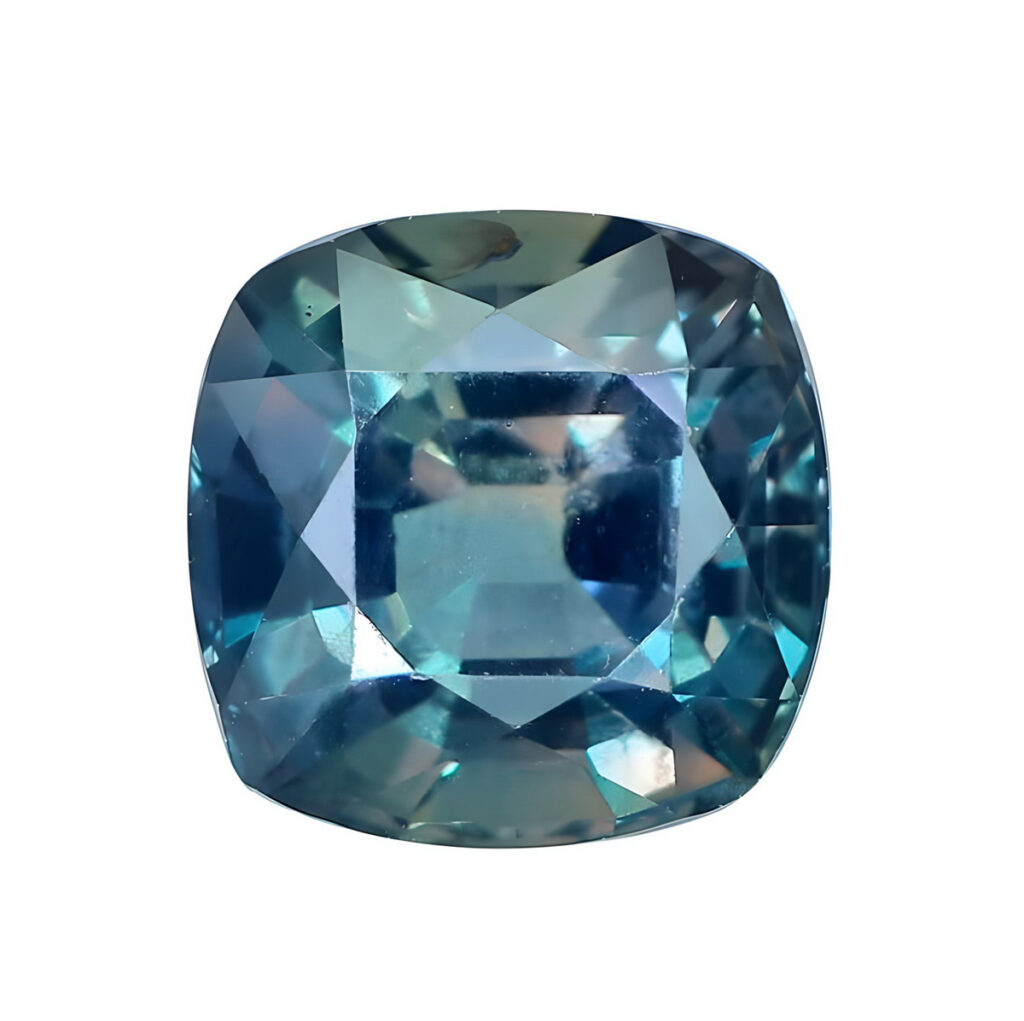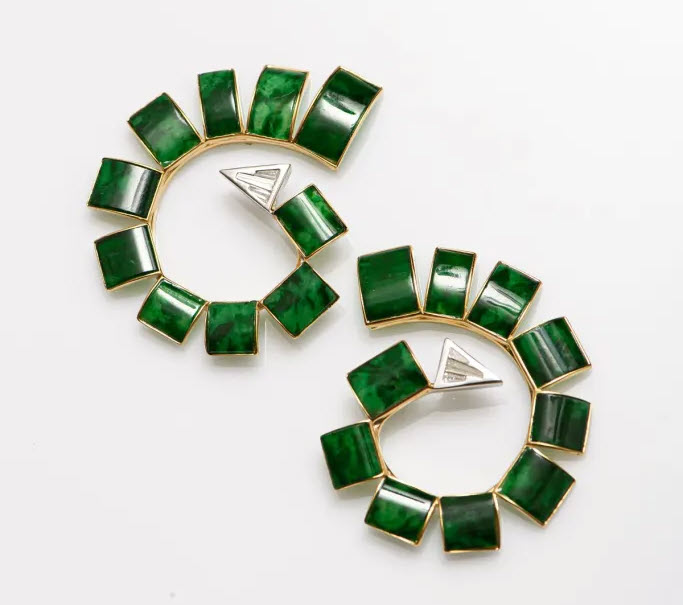This widespread violet gem continues to dazzle and is a perfect fit for this year’s Pantone color.
Amethyst is arguably one of the most distinctive and ubiquitous gemstones in decorative jewelry. In ancient times, it was considered as valuable as ruby and emerald, and it has associations with mythology, Saint Valentine and high-ranking clerics of the Catholic church. Legend has it that the semiprecious quartz got its name from the nymph Amethyste, who came under the wrath of Bacchus, the god of wine. For this reason, these gems were often studded or carved into goblets as protection against intoxication and to stave off evil spells. Today, esoterica adherents believe the calming February birthstone possesses a tranquilizing energy, clearing the mind and relieving stress. The first known amethyst mines were discovered in the 18th century in Russia and Brazil, with Russian specimens being the most prized for their deep “imperial” purple. “With a distinctive red secondary hue, [the Russian variety] is truly luminous and has a richness to it that makes it very desirable,” says Sara Thomeier, head of jewelry for the Americas at auction house Phillips. The most prolific primary deposits today are in Uruguay, Zambia and southern Brazil. Other notable sources include Rwanda, India, Morocco, Arizona and Montana, with limited production in Sri Lanka, Burma and Russia.

Universal Appeal
With Pantone’s announcement of “Very Peri” as its 2022 color of the year — encompassing shades of blue and a violet-red undertone — the demand for amethyst will likely rise, believes Clement Sabbagh of Brazilian gemstone specialist Ben Sabbagh Bros. He has seen consistent interest in the stone, in all qualities. Indeed, a resurgence of pastel shades in the US market is pushing up sales of lighter-colored amethysts, says Eric Braunwart, founder of Columbia Gem House. But overall demand for the stone is “muted,” he reports. “Amethyst is selling, but not like it was 10 years ago…. I would love to see amethyst become more popular again, but on the broader market, it is not a ‘hot’ gem variety.” Much of today’s demand comes from lower-priced jewelry, according to Braunwart. “In the US, TV stations sold millions of carats in the 2000s [via home shopping networks], but seem to have saturated that market. It still sells, because it is available, well known, affordable and a birthstone.” It has other advantages as well. “Generally speaking, amethyst is quite free of inclusions by the nature of the crystal, so finding clean stones is not very difficult,” comments Thomeier. “The most excitement we see is when we find a big bright stone that is supersaturated.” Factors such as color, clarity, size and a “velvety” appearance are usually what determine the price of an amethyst, as opposed to origin. That said, amethyst from responsible sources may command higher prices due to higher production costs. Major markets for amethyst include the US, Europe, Australia, New Zealand and Japan. The US consumes large amounts of Brazilian and Zambian amethysts of all qualities, according to Sabbagh, whereas Europe has considerable demand for higher-priced stones. “China has consumed a large amount of commercial material for beads and carvings, as well as geodes produced in southern Brazil and Uruguay,” he adds.

Purple Glam
From very light shades to deep, saturated purple, amethyst offers jewelers an extensive color palette. Bright, mood-boosting jewels in clashing, mismatched hues are very much in vogue. French designer Lydia Courteille likes to use amethyst to add strong contrast and vibrant color to her eclectic pieces. She enjoys mixing it with emeralds or citrines, declaring this “a magnificent color code.” Bulgari, too, has gone for the emerald and citrine combination with amethyst, as well as matching it with turquoise. Hexagon cuts in sleek, clean settings have come to the fore, a look that’s both bold and minimalist. Amethysts also lend themselves well to the briolette cut, and bunching them together can create the impression of hanging grapes. Courteille’s Turkey earrings are a great example, embracing the textural delight of cabochons and round briolettes. In keeping with the appetite for refreshing pastel colors, a subset of pale amethyst known as Rose de France has garnered favorable attention. “These pale-pink amethysts are very pretty,” says Courteille. “They have a tint of mauve that makes them different [from] other pink stones.”

Designer Sweta Jain of Goshwara has noticed a trend of combining lavender amethysts with rose gold. Her own amethyst pieces incorporate a range of smooth and faceted stones. “I have always used amethyst in big, bold designs, but during the pandemic, I realized I had to make pieces that were smaller, more wearable and more casual. I believe we are seeing a similar trend across the industry.” With its sizable crystals and transparency, amethyst is also ideal for cutting into cameos and intaglio engravings. Contemporary lapidarists like Julia Maria Künnap and Naomi Sarna harness these qualities to suggest pools of rippling water or melted matter. Künnap appreciates the creative freedom she has with quartz, while Sarna, whose work pays homage to motion, says she enjoys “carving amethyst with gradations of color, from very light to dark. This inspires me to carve in more complex patterns than I might if it was a solid block of color.”

Turning up the heat
The availability of synthetic amethyst has significantly impacted the trade. Produced through the hydrothermal method since the 1970s, it is chemically identical to its natural counterpart and has become costly to distinguish. The resulting lack of consumer confidence has caused a drop in market prices. “Amethyst prices have remained the same or lower than when I first came into the industry 45 years ago,” says Braunwart. “This is because of the chronic mixing of synthetics into natural parcels. The rough sells between $25 and $90 per kilogram, whereas natural quartz of the same clarity can be in the $1,000- to $5,000-per-kilogram range. You will also get nearly twice as many cut carats from a kilogram of synthetic compared to natural material.” To avoid concerns about synthetics or unknown treatments, Sabbagh’s advice is to know your sources. Columbia Gem House has taken the same approach, developing strong relationships with its mine suppliers for over 30 years. “What you want to look for is a supplier that carefully inspects the rough they purchase, cuts in a closed shop, and does not add additional stones that were purchased ‘off the street’ into their parcels,” says Braunwart. Amethyst from certain locations is often irradiated to enhance its purple color, while heating some forms of amethyst at high temperatures can turn it into citrine, as both are types of quartz. In fact, the majority of commercial citrine on the market is actually heat-treated amethyst; natural citrine is rare. “Heating is done by small miners and traders near the mines,” explains Bangkok-based gem manufacturer Navneet Agarwal of Navneet Gems & Minerals, who sources from Brazil. “Citrine is definitely more expensive than amethyst, factoring in the heat treatment and electricity costs.”

There is also a bi-color variety of quartz called ametrine, which is mined solely in Brazil and exhibits an invigorating clash of purple and golden-yellow in the same crystal. There is no treatment process to turn amethyst to ametrine, as far as Braunwart knows. “I have seen tons of rough that is naturally bi-colored, but I’ve never seen ‘synthetic’ ametrine material, and while I do not think it exists, I cannot say for sure,” he says. Then there’s prasiolite, a light grayish-green variety of quartz that is often sold under the misnomers of green amethyst or lemon quartz. Although the Federal Trade Commission (FTC) prohibits using incorrect varietal names like these, the industry seldom abides by these guidelines in practice, according to Braunwart. “[Prasiolite] is easier to sell to consumers, and thus worth more,” he explains. “The FTC also says all treatments must be disclosed, yet 99% of the market’s prasiolite is irradiated and then heated, but no one discloses this information, either. Sabbagh, who is president of the International Coloured Gemstone Association (ICA), says all ICA members’ invoices must use standard industry disclosure codes for treatments, as well as stating the correct gemstone variety.

Secondary Market
In the past 12 months, 85% of amethyst and ametrine orders from online luxury marketplace 1stDibs were shipped to the US. Another 5% went to the UK, and 2% to Australia. The most popular items were amethyst rings, followed by earrings and necklaces, according to 1stDibs editorial director Anthony Barzilay Freund. “We have many examples of important designers using amethysts in their jewelry, such as Cartier, Bulgari and Belperron.” Thomeier from Phillips affirms that those brands command a premium. Among unsigned pieces, she’s noted a rising interest in amethyst rivière necklaces from all periods. Since amethyst has associations with an array of powers and healing properties, Thomeier has also seen them frequently in talismanic and sentimental jewels. While the quality of the amethyst itself is an important factor, it may not be able to take credit for a piece’s success. “You can always find an example of an amethyst jewel that is performing well in the secondary market, but it’s more about the design than the presence of amethyst as the driving factor,” she explains. That said, she notes, “the ability to source large specimens allows [amethyst] to be used in bold designs. Plus, its distinctive color mixes beautifully with other gemstones such as turquoise and corals, as seen in the bold ’70s and ’80s designs that are gaining popularity once again.”

Through the Ages
Amethysts have been prized for centuries, first appearing in decorative beads, ancient seals and ornaments. A signifier of wealth and status, the stone has occupied pride of place in religious and historic jewels. Although they are abundant now, amethysts were considered rare in the 18th century, when they featured in ecclesiastical jewelry and adorned royalty. Later that century, vast amounts of amethyst arrived in Europe from Brazil — notably Minas Gerais — and in the 19th century, supply came in from Brazil’s Rio Grande do Sul region and Uruguay. Then came Russian amethysts from the Ural Mountains, which boasted exceptional quantities and qualities that impacted the jewelry arts from that period. “This availability changed the way amethyst was used in European, French and English jewelry,” explains Portugal-based author and gem education consultant Rui Galopim de Carvalho. “Amethyst rivières, parure sets, foil-backed rings, and bishop’s crosses in intricate foliate settings all became popular.” Foiling of gems in closed settings was a common practice during the 18th century. “The deposits, particularly from Brazil, showed subtle differences in hue, so many jewelers used a colored foil-back setting to intensify the color, uniformity and brilliance of the stone,” says Carvalho. Foliate, scroll and cluster motifs dominated the designs of the mid-18th to 19th centuries, and amethysts were often set in opulent gold filigree called cannetille.

The practice of engraving amethysts has been around for millennia. In the Roman period, craftspeople often used diamond-tipped tools for such delicate workings. “There are numerous examples of engraved amethysts and other gems using classical motifs,” Carvalho relates. Later on, the suffragette movement used amethyst to draw attention to its activism. Since green, white and violet were seen as a secret code for “Give Women Votes,” supporters of the movement would pair amethysts and peridot with diamonds, enamel or seed pearls in their jewelry. In the 20th century, the stone ceased to be rare and became widely available. During the Prohibition era and Retro period through the mid-century, jewelers used large bold amethysts to dramatic effect, valuing the stone for its size, its vibrant color, and its suitability for cutting into geometric shapes. Between the 1960s and ’70s, avant-garde jewelers like Jean Vendome, Andrew Grima and John Donald experimented with amethyst in radically modern ways, whether it was faceted, uncut or completely rough.

Main image: Iris amethysts from Columbia Gem House. Photo: Columbia Gem House.












